fuel pressure CHEVROLET CAMARO 1996 4.G Owners Manual
[x] Cancel search | Manufacturer: CHEVROLET, Model Year: 1996, Model line: CAMARO, Model: CHEVROLET CAMARO 1996 4.GPages: 402, PDF Size: 21.38 MB
Page 9 of 402
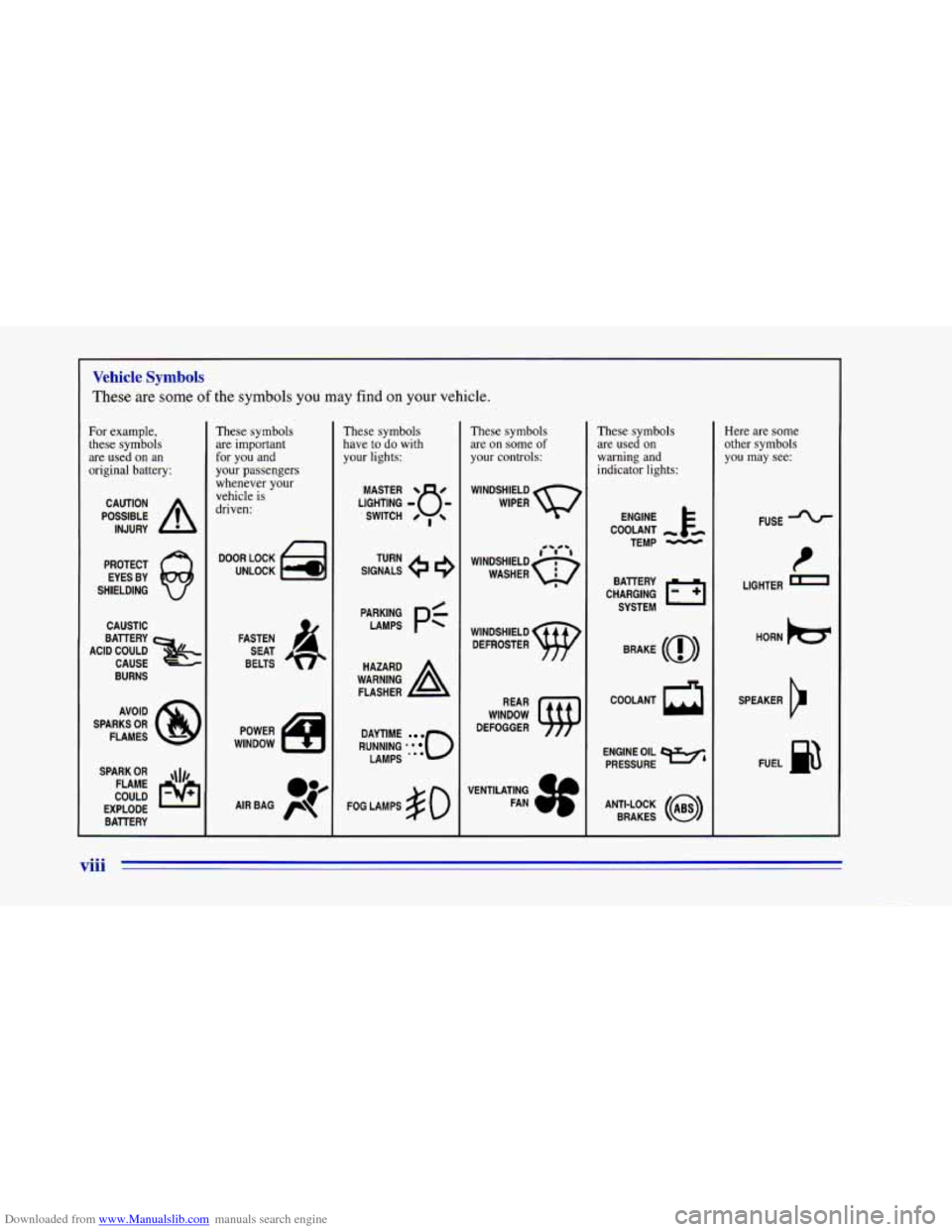
Downloaded from www.Manualslib.com manuals search engine Vehicle Symbols
These are some of the symbols you may find on your vehicle.
For example,
these symbols
are used on an
original battery:
POSSIBLE A
CAUTION
INJURY
PROTECT EYES BY
SHIELDING
Q
CAUSTIC
ACID COULD BATTERY
CAUSE
BURNS
SPARK
OR ,\I/,
COULD FLAME
EXPLODE BATTERY
These symbols
are important
for you and
your passengers
whenever your
vehicle
is
driven:
DOOR LOCK
UNLOCK
FASTEN SEAT
BELTS
These symbols
have to do with
your lights:
SIGNALS e 9
TURN
RUNNING
' ' 0
DAYTIME a
LAMPS
FOG LAMPS
$0
These symbols
are on some
of
your controls:
WIPER w
WINDSHIELD
DEFROSTER
VENTILATING FAN
These symbols are
used on
warning and
indicator lights:
COOLANT -
TEMP -
CHARGING I-1
BATTERY
SYSTEM
BRAKE
(a)
COOLANT a
ENGINE OIL e,
PRESSURE
ANTI-LOCK
(a)
BRAKES
Here are some
other symbols
you may see:
FUSE -%-
LIGHTER n
HORN k3
SPEAKER
b
FUEL p3
viii
Page 140 of 402
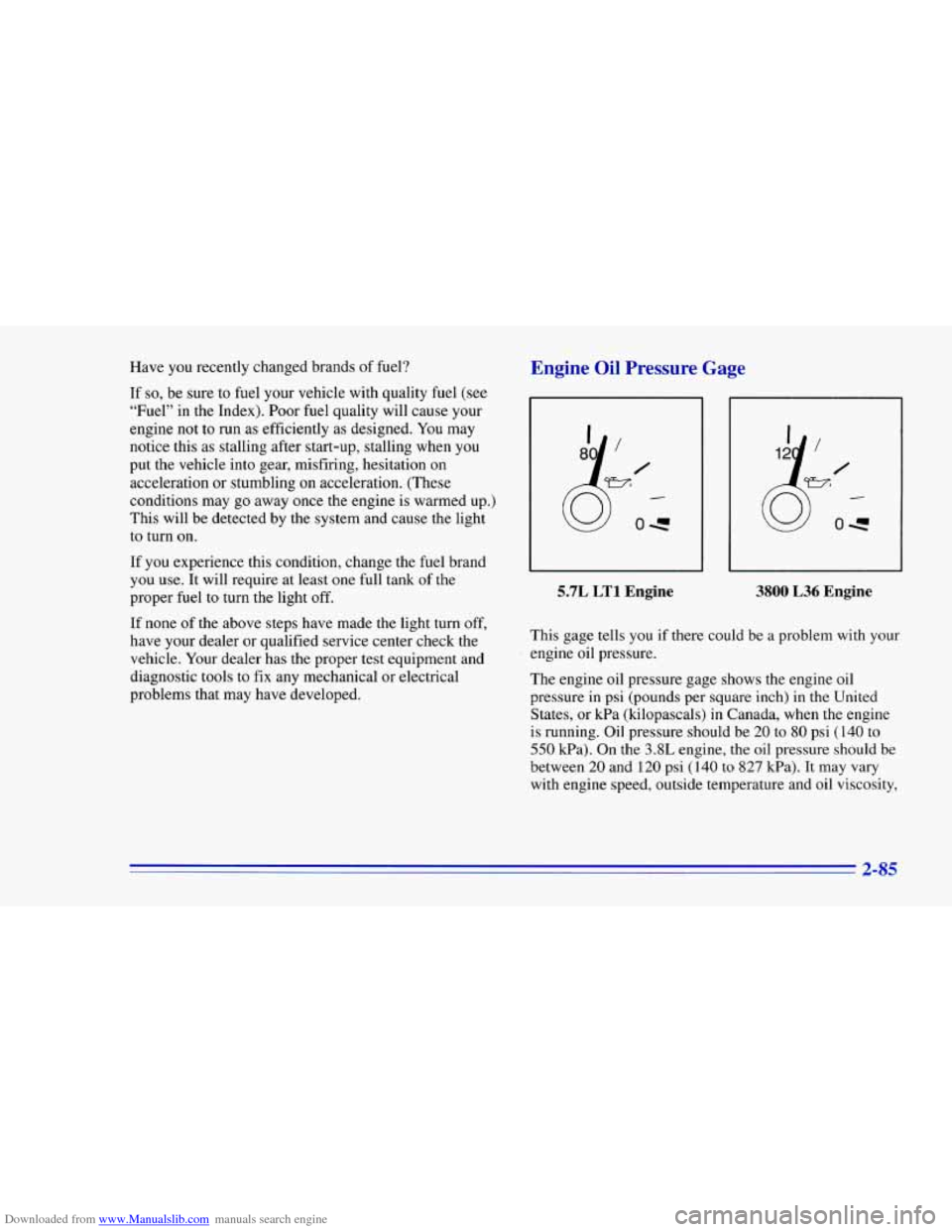
Downloaded from www.Manualslib.com manuals search engine Have you recently changed brands of fuel?
If
so, be sure to fuel your vehicle with quality fuel (see
“Fuel” in the Index). Poor fuel quality will cause your
engine not to run as efficiently as designed. You may
notice this as stalling after start-up, stalling when you
put the vehicle into gear, misfiring, hesitation on
acceleration or stumbling
on acceleration. (These
conditions may
go away once the engine is warmed up.)
This will be detected by the system and cause the light
to turn on.
If you experience this condition, change the fuel brand
you
use. It will require at least one full tank of the
proper fuel to turn the light
off.
If none of the above steps have made the light turn off,
have your dealer or qualified service center check the
vehicle. Your dealer has the proper test equipment and
diagnostic tools to fix any mechanical
or electrical
problems that may have developed.
Engine Oil Pressure Gage
5.7L LT1 Engine 3800 L36 Engine
This gage tells you if there could be a problem with your
engine oil pressure.
The engine oil pressure gage shows the engine oil
pressure in psi (pounds per square inch)
in the United
States, or kPa (kilopascals)
in Canada, when the engine
is running. Oil pressure should be
20 to 80 psi (140 to
550 kPa). On the 3.8L engine, the oil pressure should be
between
20 and 120 psi (140 to 827 kPa). It may vary
with engine speed, outside temperature and oil viscosity,
2-85
Page 187 of 402
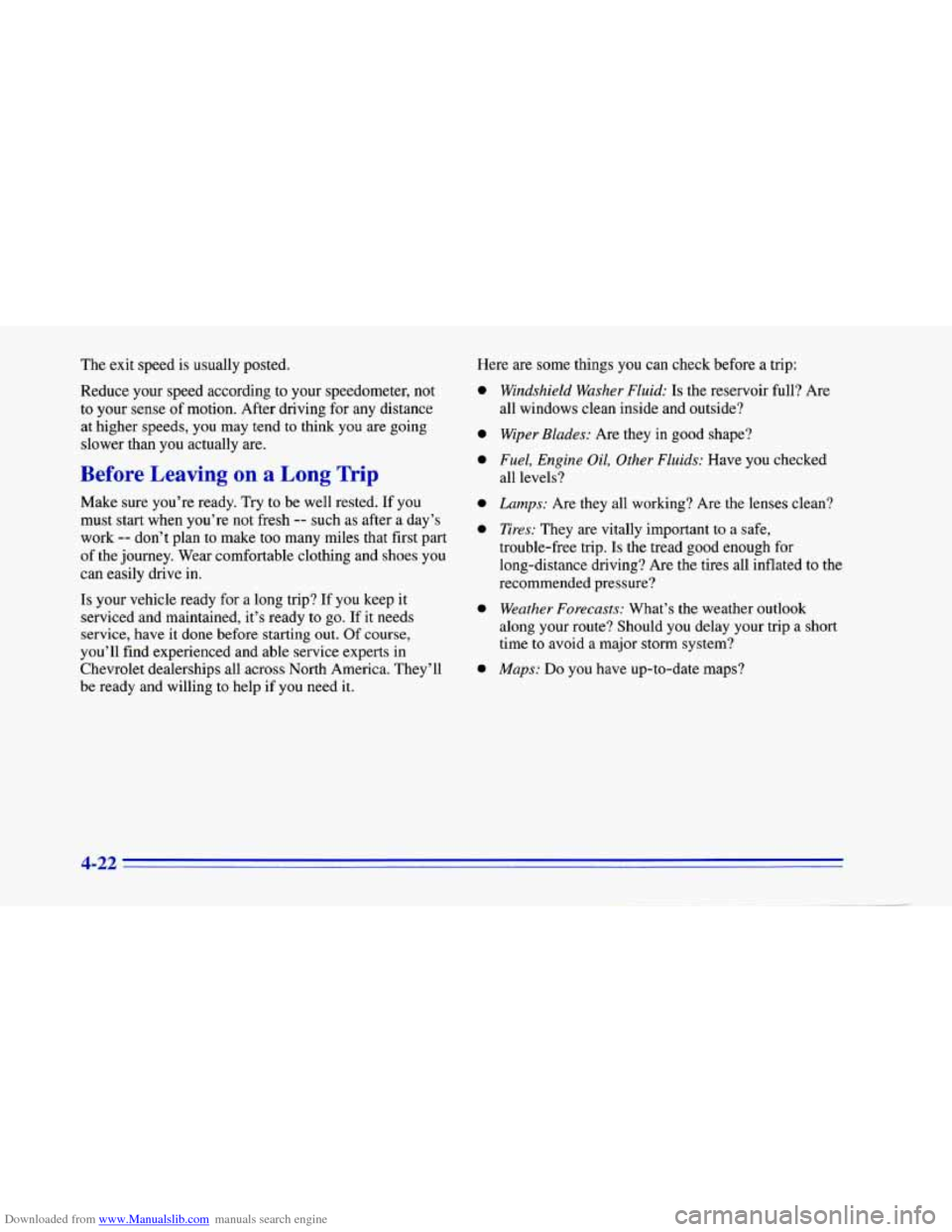
Downloaded from www.Manualslib.com manuals search engine The exit speed is usually posted.
Reduce your speed according to your speedometer, not
to your sense of motion. After driving for
any distance
at higher speeds, you may tend to think you are going
slower than you actually are.
Before Leaving on a Long Trip
Make sure you’re ready. Try to be well rested. If you
must start when you’re not fresh
-- such as after a day’s
work
-- don’t plan to make too many miles that first part
of the journey. Wear comfortable clothing and shoes you
can easily drive
in.
Is your vehicle ready for a long trip? If you keep it
serviced and maintained, it’s ready to
go. If it needs
service, have it done before starting out.
Of course,
you’ll find experienced and able service experts
in
Chevrolet dealerships all across North America. They’ll
be ready and willing to help if you need
it.
Here are some things you can check before a trip:
0
0
0
0
0
0
0
Windshield Washer Fluid: Is the reservoir full? Are
all windows clean inside and outside?
Wiper Blades: Are they in good shape?
Fuel, Engine Oil, Other Fluids: Have you checked
all levels?
Lamps: Are they all working? Are the lenses clean?
Tires: They are vitally important to a safe,
trouble-free trip.
Is the tread good enough for
long-distance driving? Are
the tires all inflated to the
recommended pressure?
Weather Forecasts: What’s the weather outlook
along your route? Should you delay your trip a short
time to avoid
a major storm system?
Maps: Do you have up-to-date maps?
Page 194 of 402
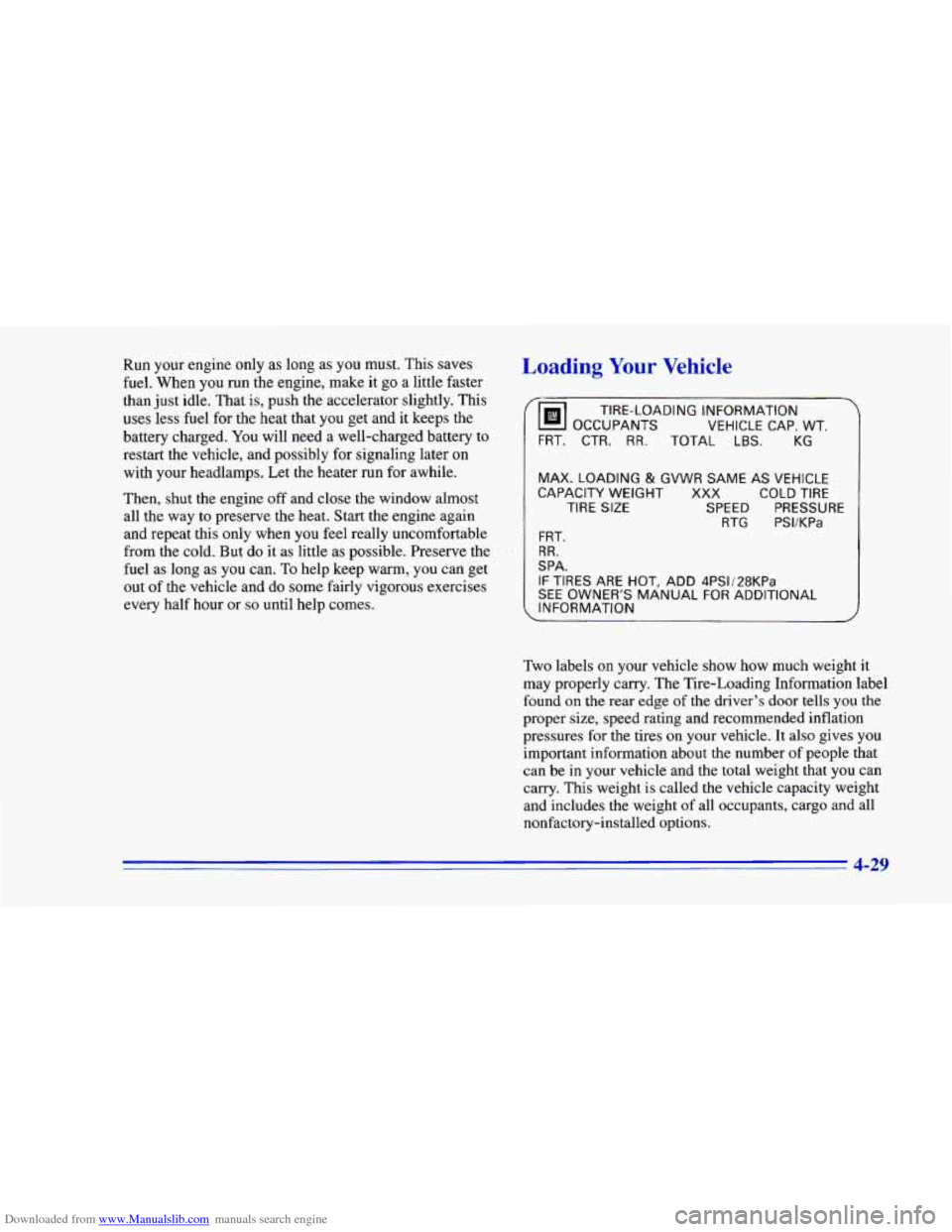
Downloaded from www.Manualslib.com manuals search engine Run your engine only as long as you must. This saves
fuel. When you run the engine, make it go a little faster
than just idle. That is, push the accelerator slightly. This
uses less fuel for the heat that
you get and it keeps the
battery charged. You will need a well-charged battery to
restart the vehicle, and possibly for signaling later on
with your headlamps. Let the heater run for awhile.
Then, shut the engine off and close the window almost
all the way to preserve the heat. Start the engine again
and repeat this only when you feel really uncomfortable
from the cold. But do it as little as possible. Preserve the
fuel
as long as you can. To help keep warm, you can get
out of the vehicle and do some fairly vigorous exercises
every half hour or
so until help comes.
Loading Your Vehicle
' OCCUPANTS
VEHICLE CAP. WT.
TIRE-LOADING INFORMATION
FRT.
CTR. RR. TOTAL LBS. KG
MAX. LOADING & GVWR SAME AS VEHICLE
CAPACITY WEIGHT XXX COLD TIRE
TIRE
SIZE SPEED PRESSURE
RTG PSI/KPa
FRT.
RR.
SPA.
IF TIRES ARE HOT, ADD 4PSIi28KPa
SEE OWNER'S MANUAL FOR ADDITIONAL
INFORMATION
Two labels on your vehicle show how much weight it
may properly carry. The Tire-Loading Information label
found on the rear edge of the driver's door tells you the
proper size, speed rating and recommended inflation
pressures for the tires on your vehicle.
It also gives you
important information about the number
of people that
can be
in your vehicle and the total weight that you can
carry. This weight is called the vehicle capacity weight
and includes the weight of all occupants, cargo and all
nonfactory-installed options.
4-29
Page 292 of 402
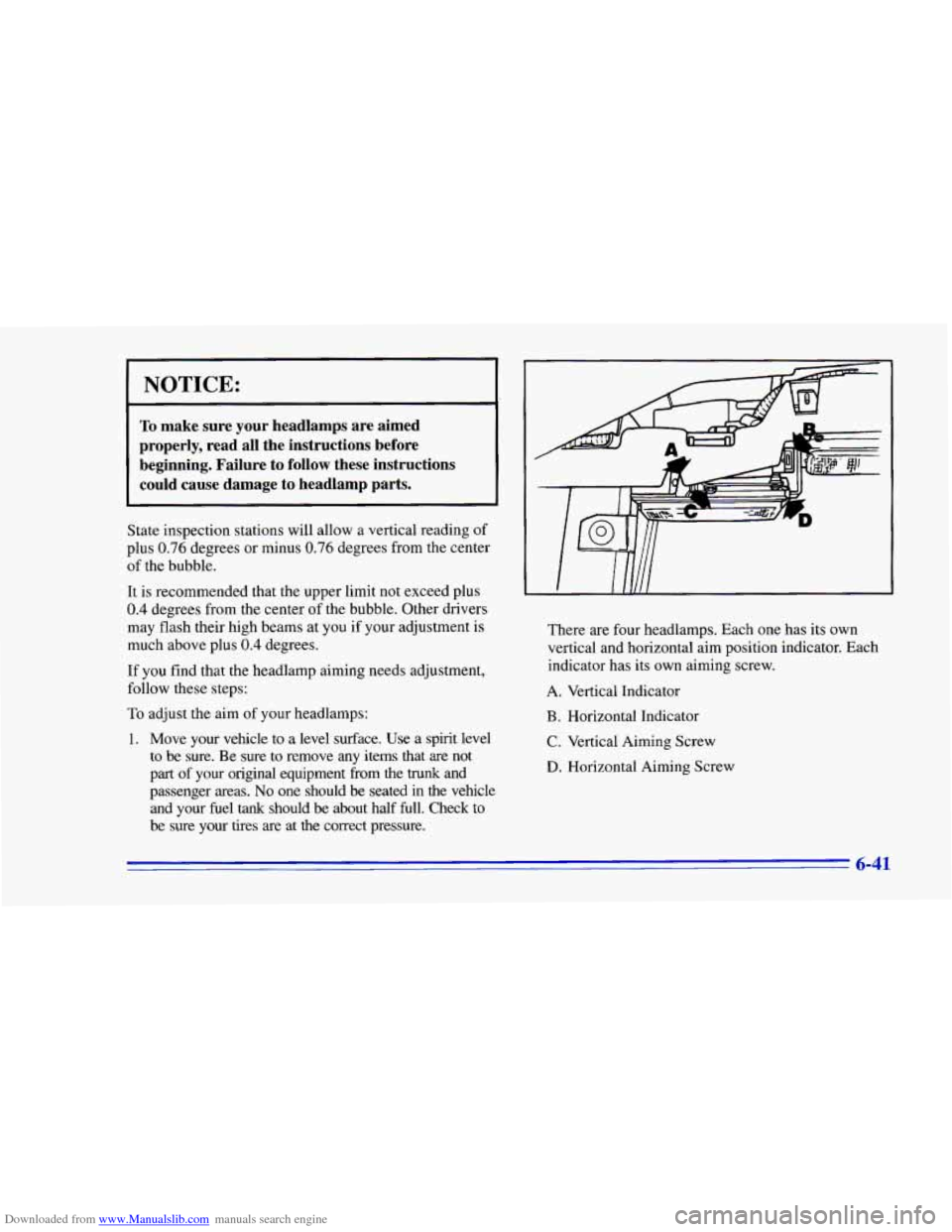
Downloaded from www.Manualslib.com manuals search engine NOTICE:
To make sure your headlamps are aimed
properly, read all the instructions before
beginning. Failure to follow these instructions
could cause damage to headlamp parts.
State inspection stations will allow a vertical reading of
plus 0.76 degrees or minus 0.76 degrees from the center
of the bubble.
It
is recommended that the upper limit not exceed plus
0.4 degrees from the center of the bubble. Other drivers
may flash their high beams at you if your adjustment is
much above plus
0.4 degrees.
If you find that the headlamp aiming needs adjustment,
follow these steps:
To adjust the aim of your headlamps:
1. Move your vehicle to a level surface. Use a spirit level
to be sure. Be sure to remove any items that are not
part of your original equipment from the trunk and
passenger areas. No one should be seated in the vehicle
and your
fuel tank should be about half full. Check to
be sure your tires are at the correct pressure. There are four
headlamps. Each
one has its own
vertical and horizontal aim position indicator. Each
indicator has its own aiming screw.
A. Vertical Indicator
B. Horizontal Indicator
C. Vertical Aiming Screw
D. Horizontal Aiming Screw
6-41
Page 299 of 402
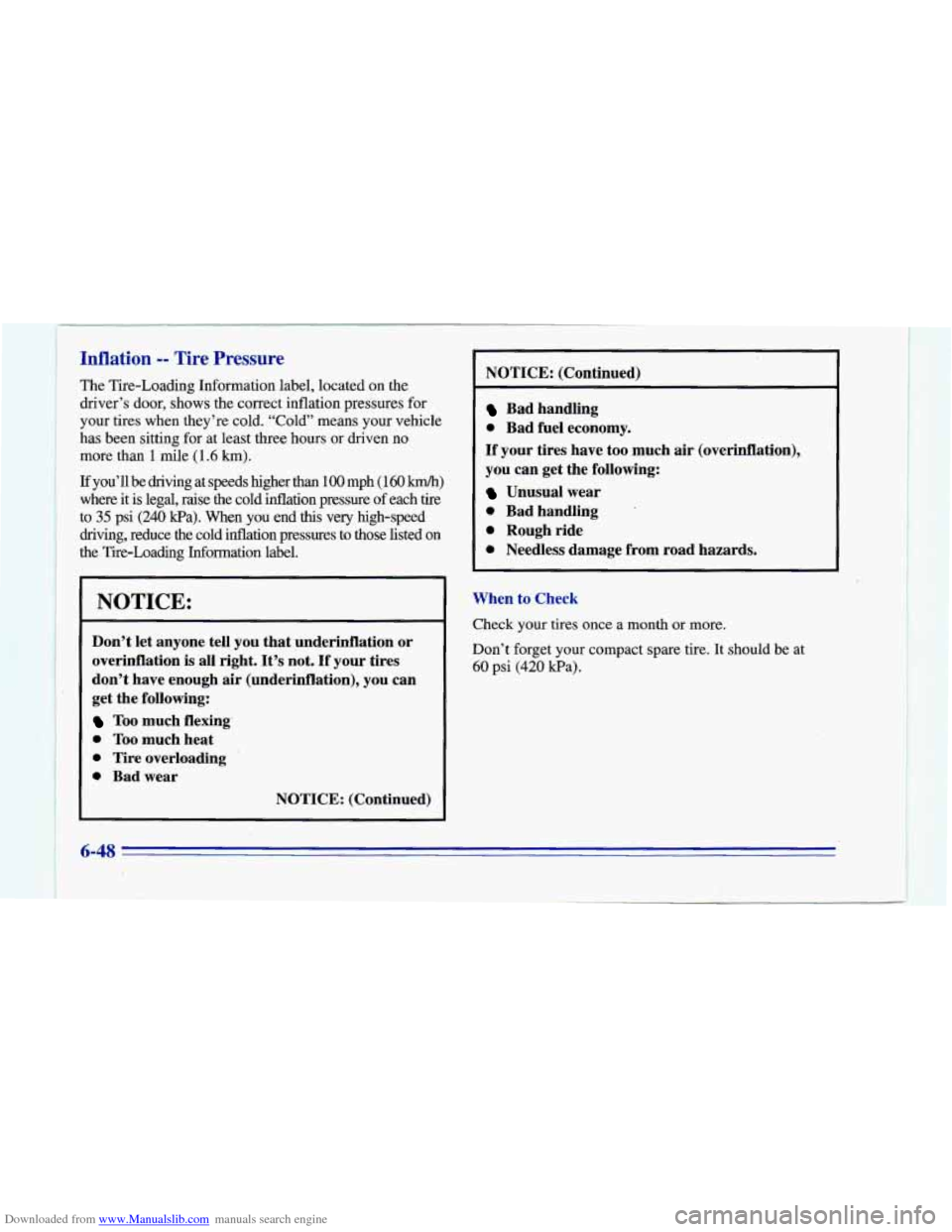
Downloaded from www.Manualslib.com manuals search engine Inflation -- Tire Pressure
The Tire-Loading Information label, located on the
driver’s door,
,shows the correct inflation pressures for
your tires when they’re cold. “Cold” means your vehicle\
has been
sitting for at least three hours or driven no
more than
1 mile (1.6 km).
If you’ll be driving at speeds higher than 100 mph (160 km/h)
where it is legal, raise the cold inflation pressure of each tire
to
35 psi (240 Ea). When you end this very high-speed
driving, reduce the cold inflation pressures to those listed on
the Tire-Loading Information label.
NOTICE:
Don’t let anyone tell you that underinnation or
overinflation
is all right. It’s not. If your tires
don’t have enough,
air (underinflation), you can
get the following:
Too much flexing.’
0 Too much heat
0 Tire overloading ‘
0 Bad wear
NOTICE: (Continued) NOTICE: (Continued)
Bad
handling
0 Bad fuel economy.
If your tires have too much air (overinflation),
you can
get the following:
Unusual wear
0 Bad handling
0 Rough ride
0 Needless damage from road hazards.
When
to Check
Check your tires once a month or more.
Don’t forget your compact spare tire.
It should be at
60 psi (420 kPa).
6-48
Page 366 of 402
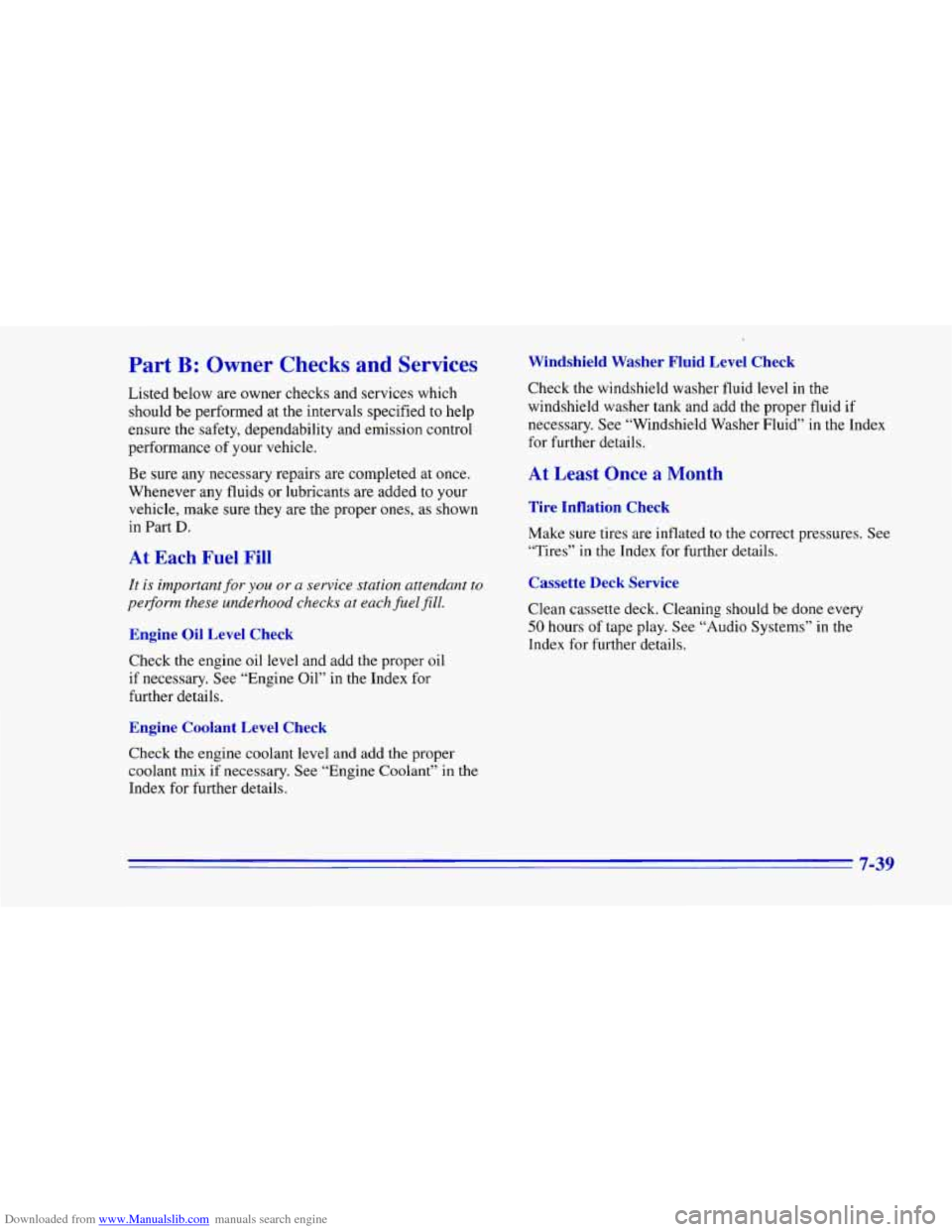
Downloaded from www.Manualslib.com manuals search engine Part B: Owner Checks and Services
Listed below are owner checks and services which
should be performed at the intervals specified to help
ensure the safety, dependability and emission control
performance
of your vehicle.
Be sure any necessary repairs are completed at once.
Whenever
any fluids or lubricants are added to your
vehicle, make sure they are the proper ones, as shown
in Part
D.
At Each Fuel Fill
It is important for you or a service station attendant to
perform these underhood checks at each fuel fill.
Engine Oil Level Check
Check the engine oil level and add the proper oil
if necessary. See “Engine Oil” in the Index for
further details.
Engine Coolant Level Ch - -k
Check the engine coolant levei and add the proper
coolant mix if necessary. See “Engine Coolant”
in the
Index for further details.
Windshield Washer Fluid Level Check
Check the windshield washer fluid level in the
windshield washer tank and add
the proper fluid if
necessary. See “Windshield Washer Fluid”
in the Index
for further details.
At Least Once a Month
Tire Inflation Check
Make sure tires are inflated to the correct pressures. See
“Tires” in the Index for further details.
Cassette Deck Service
Clean cassette deck. Cleaning should be done every
50 hours of tape play. See “Audio Systems” in the
Index for further details.
7-39
Page 393 of 402
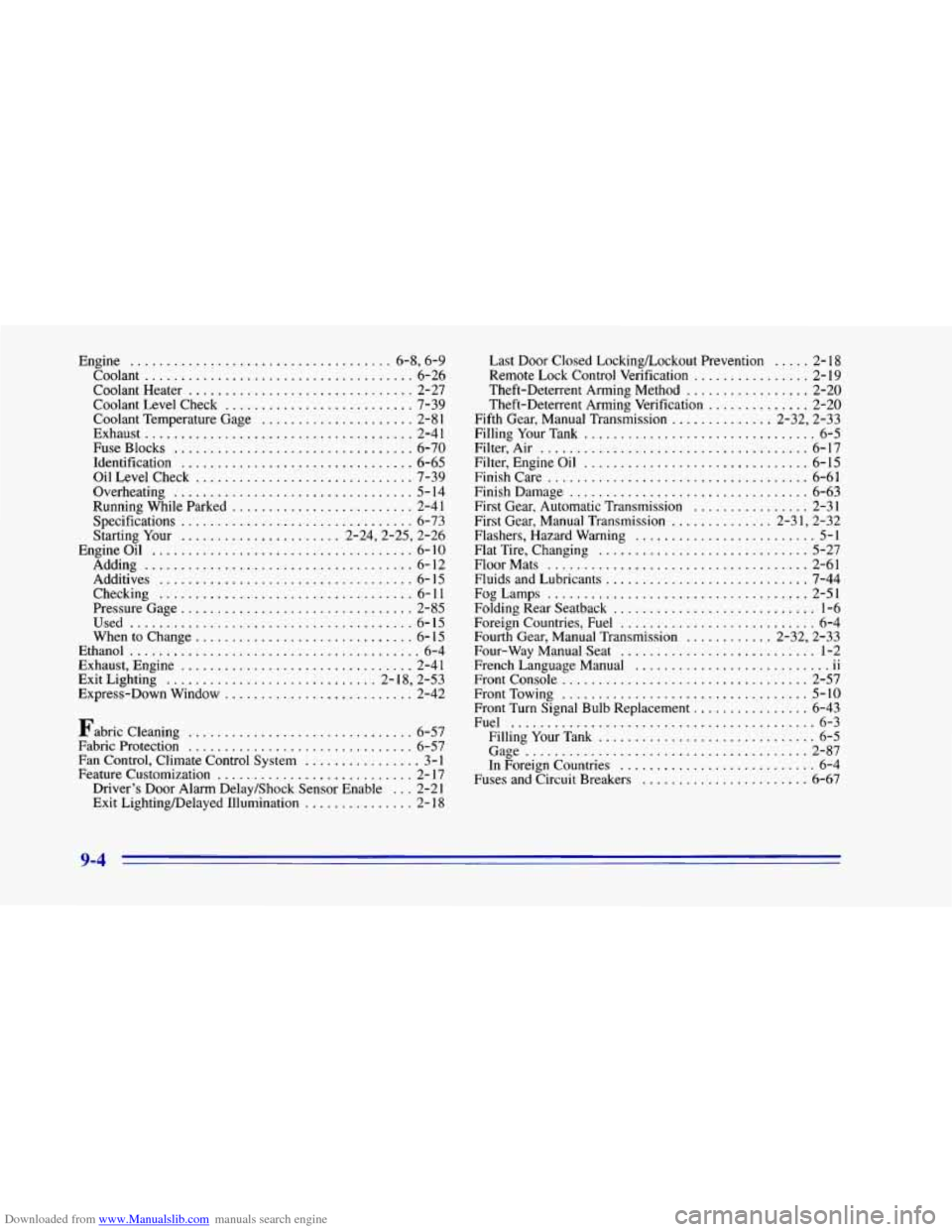
Downloaded from www.Manualslib.com manuals search engine Engine .................................... 6.8. 6.9
Coolant
..................................... 6-26
Coolant Heater
............................... 2-27
Coolant Level Check
.......................... 7-39
Coolant Temperature Gage
..................... 2-8 1
Exhaust ..................................... 2-41
Fuse Blocks
................................. 6-70
Identification
................................ 6-65
Oil Level Check
.............................. 7-39
Running While Parked
......................... 2-41
Starting Your
...................... 2-24.2-25. 2-26
Engineoil
.................................... 6-10
Adding ..................................... 6-12
Additives
................................... 6-15
Checking
................................... 6-11
Used
....................................... 6-15
Whentochange .............................. 6-15
Ethanol ........................................ 6-4
Overheating
................................. 5- 14
Specifications
................................ 6-73
Pressure Gage
................................ 2-85
Exhaust. Engine
................................ 2-41
Exit Lighting
............................. 2-18. 2-53
Express-Down Window
.......................... 2-42
Fabric Cleaning
............................... 6-57
Fabric Protection ............................... 6-57
Fan Control. Climate Control System ................ 3- 1
Feature Customization ........................... 2- 17
Driver’s Door Alarm Delay/Shock Sensor Enable ... 2-21
Exit Lighting/Delayed Illumination
............... 2- 18 Last Door Closed
LockingLockout Prevention
..... 2- 18
Remote Lock Control Verification
................ 2-19
Theft-Deterrent Arming Method
................. 2-20
Theft-Deterrent Arming Verification
.............. 2-20
Fifth Gear. Manual Transmission .............. 2.32. 2.33
FillingYourTank
................................ 6-5
Filter. Air ..................................... 6-17
Filter. Engine Oil
............................... 6-15
Finish Care
.................................... 6-61
Finish Damage
................................. 6-63
First Gear. Automatic Transmission
................ 2-31
First Gear. Manual Transmission
............... 2-3 1. 2-32
Flashers. Hazard Warning
......................... 5-1
Flat Tire. Changing
............................. 5-27
Floor Mats
.................................... 2-61
Fluids and Lubricants
............................ 7-44
FogLamps
.................................... 2-51
Folding Rear Seatback
............................ 1-6
Foreign Countries. Fuel
........................... 6-4
Fourth Gear. Manual Transmission ............ 2-32. 2-33
Four-Way Manual Seat
........................... 1-2
French Language Manual
........................... ii
FrontConsole .................................. 2-57
FrontTowing
.................................. 5-10
Front Turn Signal Bulb Replacement
................ 6-43
Fuel
.......................................... 6-3
Filling Your Tank
.............................. 6-5
Gage ....................................... 2-87
In Foreign Countries
........................... 6-4
Fuses and Circuit Breakers
....................... 6-67
9-4
Page 394 of 402
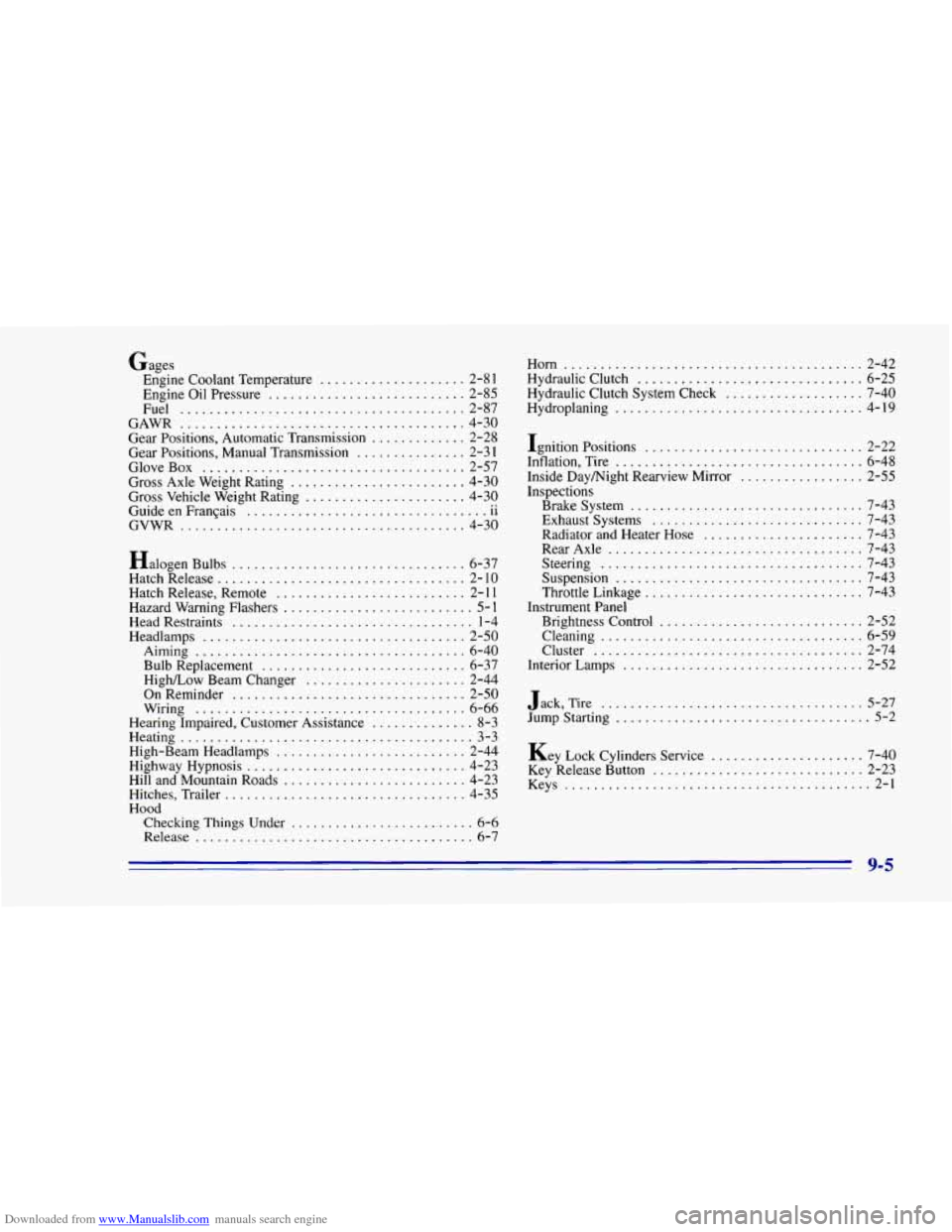
Downloaded from www.Manualslib.com manuals search engine Gages Engine Coolant Temperature
.................... 2-8 1
Engine Oil Pressure ........................... 2-85
Fuel ....................................... 2-87
Gear Positions. Automatic Transmission
............. 2-28
Gear Positions. Manual Transmission
............... 2-3 1
GloveBox .................................... 2-57
Gross Axle Weight Rating ........................ 4-30
Gross Vehicle Weight Rating
...................... 4-30
Guide
en FranCais 11
GAWR ....................................... 4-30
.. .................................
GVWR ....................................... 4-30
Halogen Bulbs
................................ 6-37
Hatch Release
.................................. 2- 10
Hatch Release. Remote .......................... 2- 1 1
Hazard Warning Flashers .......................... 5-1
Head Restraints ................................. 1-4
Headlamps
.................................... 2-50
Aiming
..................................... 6-40
Bulb Replacement
............................ 6-37
HighLow Beam Changer
...................... 2-44
OnReminder
................................ 2-50
Wiring
..................................... 6-66
Hearing Impaired, Customer Assistance .............. 8-3
Heating
........................................ 3-3
High-Beam Headlamps
.......................... 2-44
Highway Hypnosis
.............................. 4-23
Hill and Mountain Roads
......................... 4-23
Hitches, Trailer
................................. 4-35
Hood Checking
Things Under ......................... 6-6
Release ...................................... 6- 7
Horn ......................................... 2-42
Hydraulic Clutch
............................... 6-25
Hydraulic Clutch System Check
................... 7-40
Hydroplaning
.................................. 4-19
Ignition Positions .............................. 2.22
Inflation. Tire
.................................. 6-48
Inside Daymight Rearview Mirror
................. 2-55
Inspections Brakesystem
................................ 7-43
Exhaust Systems
............................. 7-43
Radiator and Heater Hose
...................... 7-43
RearAxle
................................... 7-43
Steering
.................................... 7-43
Suspension
.................................. 7-43
Throttle Linkage
............................ 7-43
Brightness Control
............................ 2-52
Cleaning
.................................... 6-59
Cluster
..................................... 2-74
Interior Lamps
................................. 2-52
Jack. Tire .................................... 5-27
Jump Starting ................................... 5-2
Key Lock Cylinders Service
..................... 7-40
Key Release Button
............................. 2-23
Keys
.......................................... 2-1
Instrument
Panel